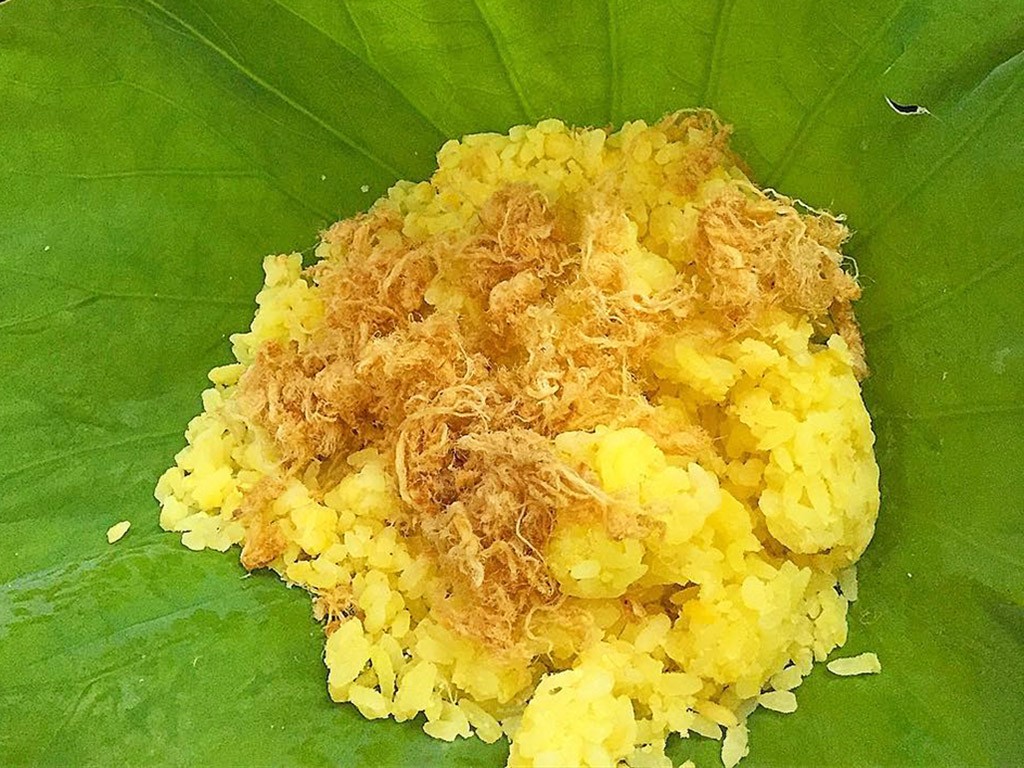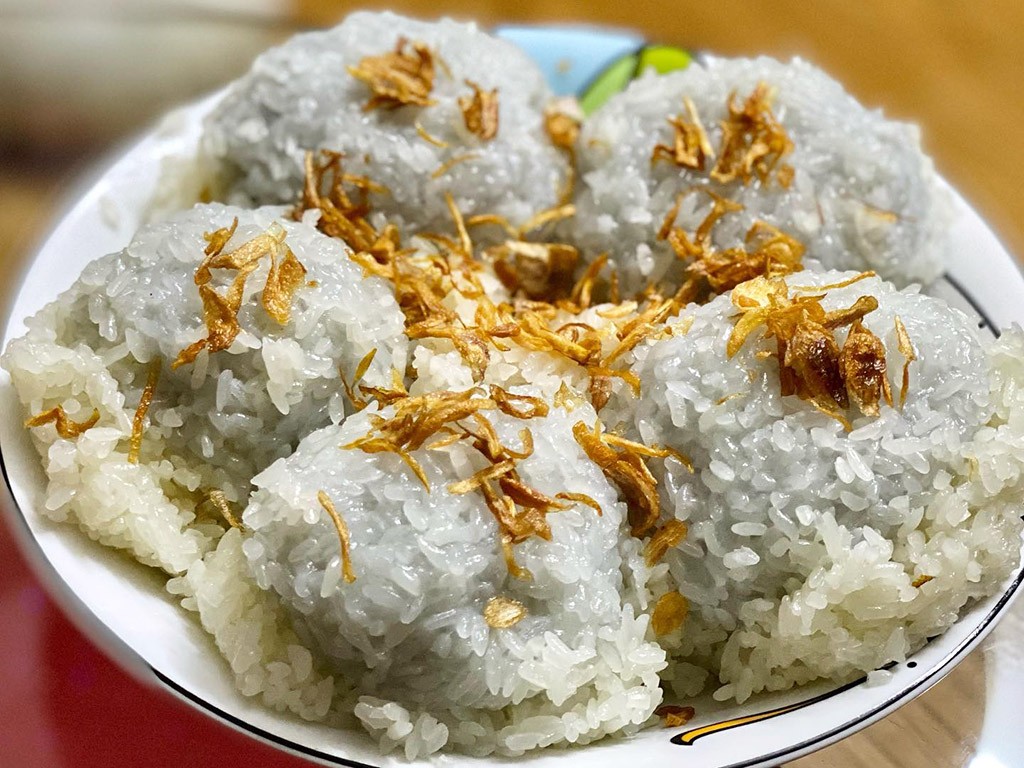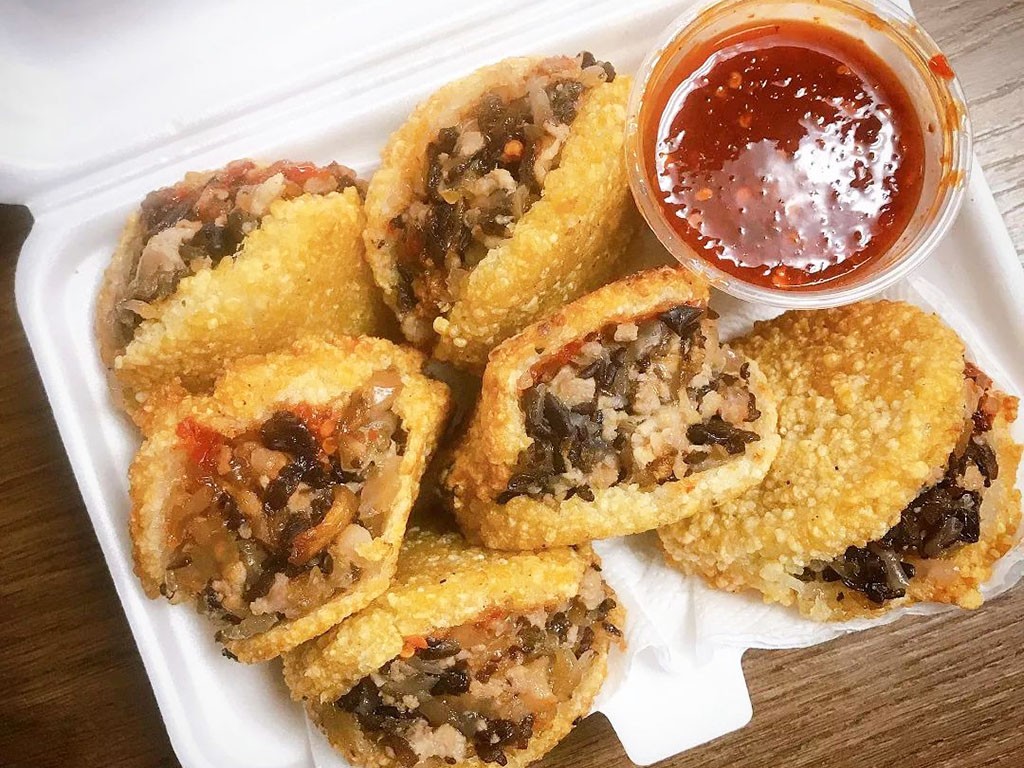Are you curious about Vietnamese cuisine and wondering if sticky rice, or xoi, is a dietary staple? Absolutely! Sticky rice holds a special place in Vietnamese culinary traditions, and SIXT.VN is here to guide you through the delightful world of xoi. From everyday meals to significant cultural events, xoi is an integral part of Vietnamese life. Keep reading to discover the diverse and flavorful local varieties of this beloved dish, and let SIXT.VN help you explore the rich culinary landscape of Vietnam through convenient travel services and insider tips. Discover the cultural significance and delicious variations of Vietnamese sticky rice!
1. What is Xoi and Its Significance in Vietnamese Cuisine?
Yes, sticky rice, known as xoi in Vietnamese, is indeed a common and cherished staple. In Vietnam, xoi isn’t just food; it’s a cultural icon deeply rooted in the country’s history and traditions. Let SIXT.VN enhance your cultural exploration with seamless travel solutions, making it easier to experience authentic Vietnamese cuisine.
- A Cultural Staple: Xoi accompanies Vietnamese people from daily meals to crucial life events.
- Ceremonial Importance: No ceremony is complete without xoi on offering tables and ancestors’ altars.
- Culinary Diversity: Across Vietnam, xoi tells different stories, showcasing the breadth of the country’s culinary history.
- Ancient Origins: Glutinous rice, the base of xoi, was a staple brought by ancient ethnic groups. Over time, it transformed into an indispensable offering for celebrations.
- Regional Variations: Each of Vietnam’s 63 cities and provinces has its unique xoi style, using local ingredients and cooking methods.
2. What are the Main Categories of Xoi (Sticky Rice)?
The varieties of xoi are vast, but they generally fall into two main categories: sweet and savory. Each type offers a unique culinary experience, highlighting the versatility of sticky rice in Vietnamese cuisine.
- Sweet Sticky Rice: Typically vegan, made with glutinous rice, beans, and fruits. These versions are perfect for breakfast or a sweet snack.
- Savory Sticky Rice: Accompanied by different kinds of meat and requires more elaborate cooking steps. These hearty dishes can be enjoyed any time of day.
3. What are Some Popular Sweet Xoi Varieties?
Sweet xoi offers a delightful array of flavors and colors, showcasing the creative use of natural ingredients. Here are a few popular sweet xoi varieties you should try:
-
Xoi Dau (Sticky Rice with Beans):
Xoi dau (sticky rice with beans)
- Most Common Combination: Sticky rice and beans create hundreds of varieties.
- Lucky Food: “Dau” (beans) sounds like “pass,” making it a lucky food for students before exams.
- Ingredients: Often combined with coconut milk and beans for a nutty and sweet taste.
- Bean Varieties: Black beans, black-eyed beans, mung beans, red beans, peanuts, etc.
- Popular Breakfast: Filling and portable, perfect for starting the day.
-
Xoi Ngu Sac (Five-Shade Sticky Rice):
- Specialty: A specialty of the Northwestern region for special occasions.
- Symbolic Colors: White, purple, green, yellow, and red represent elements of the universe.
- Natural Ingredients: Colors are extracted from natural ingredients.
- Red Rice (Fire): Passion and hope, colored with Gac fruit.
- Purple/Black Rice (Earth): Fertile soil, colored with “dam deng” leaves or purple dragon fruits.
- Yellow Rice (Metal): Prosperity, colored with turmeric.
- Green Rice (Wood): Development, colored with pandan extract.
- White Rice (Air): Loyalty, original color with coconut milk.
- Holiday Tradition: Offered to ancestors, praying for a good harvest.
-
Xoi Vo (Sticky Rice Balls):
 Xoi vo (sticky rice balls)
Xoi vo (sticky rice balls)- Description: Similar to xoi xeo without toppings, yellow color from mung beans.
- Texture: Dry and non-sticky outside, moist inside, formed into balls.
- Purpose: Created for easy carrying and storage for farmers.
- Cultural Significance: Served with che (sweet dessert soup) in Vietnamese worship culture, especially for baby celebrations.
-
Xoi Sau Rieng (Sticky Rice with Durian):
- Unique Combination: Mung bean sticky rice spread on baked bread, topped with durian paste and coconut milk.
- Southern Specialty: Reflects Southern people’s culinary culture, appreciating fruit-based products.
- Taste Profile: Creamy and sweet, offering a unique flavor experience.
4. What are Some Popular Savory Xoi Varieties?
Savory xoi provides a hearty and flavorful alternative, often incorporating various meats and seasonings. Here are some must-try savory xoi varieties:
-
Xoi Man (Savory Sticky Rice):
 Xoi man (savory sticky rice)
Xoi man (savory sticky rice)- Description: Similar to banh mi, but with sticky rice instead of baguette.
- Ingredients: Steamy white sticky rice base, scallion oil, pate, Vietnamese cold cuts (cha lua, cha que, Vietnamese ham, pork floss), pickled carrots, and cilantro.
- Comparison to Banh Mi: Offers the same delicious ingredients without the bread.
-
Xoi Thit Kho (Steamed Sticky Rice with Caramelized Braised Pork Belly):
- Hanoi Delicacy: A specialty of Hanoi, favored in autumn and winter.
- Rice Type: Made with yellow flower sticky rice, known for its fragrance.
- Key Component: Soft and tender caramelized pork belly.
- Balancing Flavors: Served with pickled onions, cucumber, and carrots to balance the richness.
- Serving Style: Served in a bowl or plate for dining in.
-
Xoi Khuc (Cudweed Sticky Rice):
 Xoi khuc or cudweed sticky rice
Xoi khuc or cudweed sticky rice- Origin: Named after khuc leaves, which give it a unique green color.
- Process: Khuc leaves are pounded and mixed with rice flour to form a dough.
- Filling: Pork belly and pork fat seasoned with black pepper, scallion, and mung beans.
- Texture: Chewy, mochi-like texture.
-
Xoi Xeo (Sticky Rice with Mung Bean):
- Intriguing Name: “Xeo” means inclined, referring to the way ingredients are cut.
- Ingredients: Sticky rice, mung beans (boiled and ground into a smooth paste), pork or chicken floss, and crispy fried onions.
- Skill Required: Cooking requires skill to achieve the right degree of softness and non-stickiness.
-
Xoi Chien (Crispy Sticky Rice):
 Xoi chien – crispy sticky rice
Xoi chien – crispy sticky rice- Appearance: Looks like a mini hamburger.
- Preparation: Sticky rice is formed into a round shape and deep-fried until crispy.
- Fillings: Onions, carrots, wood-ear mushrooms, jicama roots, and minced pork stir-fried with seasonings.
- Serving: Cut open and stuffed with the cooked fillings, served with a sauce made from scallion, soya sauce, chili sauce, and sugar.
5. How is Xoi Typically Eaten in Vietnam?
The way xoi is eaten depends on whether it’s sweet or savory, and understanding these traditions can enhance your culinary experience.
- Sweet Xoi:
- Consumption: Vegetarian-friendly, often eaten as breakfast or evening snacks.
- Serving Style: Served with a layer of mung bean paste, muoi me (sugar, salt, and roasted peanuts), and fresh coconut shreds.
- Packaging: Traditionally grabbed in a banana or lotus leaf, but often sold in foam containers.
- Price Range: 10,000 VND – 20,000 VND ($0.4 – $0.8).
- Savory Xoi:
- Consumption: Considered a main dish, eaten anytime during the day.
- Specialization: Sold at specialized stalls; you can’t find all varieties at one place.
- Availability: Xoi man is often sold with banh mi; xoi xeo and xoi chien are found on street food stalls; xoi khuc is sold by street vendors.
- Serving Style: Mostly takeaways, except for xoi thit kho, which is served for dining in.
- Price Range: 20,000 VND to 50,000 VND ($0.8 – $2), depending on toppings and location.
6. What is the Best Way to Find Authentic Xoi Varieties While Traveling in Vietnam?
Finding authentic xoi varieties is part of the adventure! Here are tips to help you discover the best xoi experiences:
- Explore Street Food Stalls: Street food stalls, especially in the mornings and late afternoons, are great places to find xoi xeo and xoi chien.
- Look for Street Vendors: Keep an eye out for vendors selling xoi khuc from bamboo baskets on bicycles.
- Visit Local Markets: Markets offer a variety of xoi, allowing you to sample different regional specialties.
- Ask Locals for Recommendations: Locals can guide you to the best xoi spots and hidden gems.
- Utilize SIXT.VN’s Local Insights: Rely on SIXT.VN to discover where to find these culinary delights.
7. Are There Any Cultural Considerations When Eating Xoi in Vietnam?
When enjoying xoi, it’s helpful to be aware of a few cultural considerations to show respect and enhance your experience:
- Offering to Ancestors: Be mindful that xoi is often used in offerings to ancestors.
- Eating with Hands: It is acceptable to eat xoi with your hands, especially when it is wrapped in banana leaves.
- Sharing is Common: Sharing xoi with friends and family is a common practice.
- Trying Local Specialties: Show appreciation for local culinary traditions by trying regional xoi varieties.
- Learn Basic Phrases: Knowing a few basic Vietnamese phrases, like “cam on” (thank you), can enhance your interactions.
8. How Can SIXT.VN Enhance My Culinary Journey to Discover Xoi in Vietnam?
SIXT.VN can significantly enhance your culinary journey by providing convenient and reliable services that allow you to focus on exploring the diverse world of xoi.
- Convenient Airport Transfers: Start your culinary adventure stress-free with reliable airport transfer services.
- Comfortable Hotel Bookings: Choose from a wide range of accommodations that suit your budget and preferences.
- Guided Tours: Explore Hanoi and other regions with professional and insightful guided tours.
- Flexible Car Rental: Enjoy the freedom to explore local eateries and markets at your own pace.
- Local Insights: Benefit from SIXT.VN’s local expertise to discover authentic xoi experiences.
9. What are Some Must-Try Xoi Dishes in Hanoi That SIXT.VN Recommends?
Hanoi offers a variety of xoi dishes that are a must-try for any food lover. SIXT.VN recommends the following:
- Xoi Thit Kho (Steamed Sticky Rice with Caramelized Braised Pork Belly): A Hanoi specialty, perfect for autumn and winter.
- Xoi Xeo (Sticky Rice with Mung Bean): A classic Hanoi breakfast, often found at street food stalls.
- Xoi Man (Savory Sticky Rice): A hearty and flavorful option, similar to banh mi.
- Xoi La Chuoi (Sticky Rice Wrapped in Banana Leaf): A simple yet delicious option, perfect for a quick snack.
- Xoi Ga (Sticky Rice with Chicken): Another popular savory choice, featuring tender chicken and flavorful seasonings.
10. What Are Some Recent Trends or Innovations in Xoi That Travelers Should Know?
The world of xoi is constantly evolving, with new trends and innovations that travelers should be aware of:
- Fusion Xoi: Modern chefs are experimenting with fusion xoi, combining traditional flavors with international ingredients.
- Gourmet Xoi: High-end restaurants are offering gourmet versions of xoi, using premium ingredients and innovative techniques.
- Vegan Xoi Options: With the rise of veganism, more restaurants are offering creative and delicious vegan xoi options.
- Online Xoi Delivery: Many vendors now offer online ordering and delivery services, making it easier to enjoy xoi on the go.
- Interactive Xoi Cooking Classes: Tourists can participate in cooking classes to learn how to make xoi from scratch.
FAQ Section
1. Is xoi gluten-free?
No, traditional xoi is made from glutinous rice, which contains gluten. However, some modern variations might use gluten-free ingredients.
2. Can I find xoi easily in Vietnamese restaurants abroad?
Yes, many Vietnamese restaurants abroad offer xoi, especially xoi xeo or xoi ga, but the variety may be limited compared to what you find in Vietnam.
3. What is the best time of day to eat xoi?
Sweet xoi is commonly eaten for breakfast or as a snack, while savory xoi can be enjoyed any time of day as a main meal.
4. How do I store leftover xoi?
Store leftover xoi in an airtight container in the refrigerator. Reheat it by steaming or microwaving with a little water to keep it moist.
5. Are there any regional variations of xoi I should be aware of?
Yes, each region in Vietnam has its unique xoi varieties. For example, xoi ngu sac is popular in the Northwestern region, while xoi sau rieng is a Southern specialty.
6. Can I make xoi at home?
Yes, you can make xoi at home with the right ingredients and equipment. Many recipes are available online, offering step-by-step instructions.
7. What drinks pair well with xoi?
Xoi pairs well with Vietnamese coffee, tea, or fresh fruit juices. For savory xoi, a light soup or broth can also be a good accompaniment.
8. Is xoi a healthy food choice?
Xoi can be a nutritious meal due to its carbohydrate content, but it is also high in calories. Choose varieties with added vegetables or lean proteins for a balanced meal.
9. How can I identify high-quality xoi?
High-quality xoi should have a fragrant aroma, a soft and slightly chewy texture, and fresh ingredients. The rice should be evenly cooked and not too sticky or dry.
10. Are there any special xoi dishes served during Tet (Vietnamese New Year)?
Yes, during Tet, xoi is often made in large quantities and served to guests. Xoi lac (sticky rice with peanuts) and xoi gac (sticky rice with Gac fruit) are particularly popular during this time.
Ready to embark on a culinary adventure in Vietnam? Let SIXT.VN take care of all your travel needs, from airport transfers to hotel bookings and guided tours. Explore the vibrant streets of Hanoi, savor the diverse flavors of xoi, and create unforgettable memories. Contact SIXT.VN today to plan your dream trip and discover the delicious world of Vietnamese sticky rice!
Address: 260 Cau Giay, Hanoi, Vietnam
Hotline/Whatsapp: +84 986 244 358
Website: SIXT.VN



